Posted: March 18th, 2013 | No Comments »
TALK: Tuesday 19th March 2013
7 pm for 7.30pm start
RAS Library at the Sino-British College
1195 Fuxing Zhong Lu

THE TALK:Classical Chinese garden design operates on a system of tension and balance. Designers traditionally utilized contrasts in size, spatial orientation, and conceptual significance of the various elements within a garden to achieve a harmonious overall effect. A visitor to a garden who is well-versed in the techniques of garden building will know how to appreciate not only the beauty of the scenes presented, but also the emotional and aesthetic importance of those scenes.
The lecture will focus on how to view a garden in a way that will maximize the effects of the grounds for visitors. Special attention will be given to two pairs of gardens in Suzhou, illustrating how finding the appropriate viewing technique can enhance the experience of journeying through a traditional Chinese garden.
THE WALK:will take place on Saturday 23rd March. Day trip to Suzhou by bus, visits to two gardens and lunch. Full details, cost, RSVP and booking requirements will be given in a separate event notice.
Shelly Bryant divides her year between Shanghai and Singapore, working as a teacher, writer, researcher, and translator. She is the author of three volumes of poetry, Cyborg Chimera, Under the Ash, and Voices of the Elders, a pair of travel guides, and a translation of ShengKeyi’s novel《北妹》 (Northern Girls) for Penguin Books. Shelly’s poetry has appeared in journals, magazines, and websites around the world, as well as in several art exhibitions, including dark ’til dawn, Things Disappear, and Studio White * Exhibition 2011.  You can visit her website at shellybryant.com.
RSVP: to RAS Bookings at: bookings@royalasiaticsociety.org.cn
PRIORITY BOOKING for Members until Saturday 16th March 2013.
ENTRANCE: 30 rmb (RAS members) and 80 rmb (non-members).
Includes one drink. Those unable to make the donation but wishing to attend may contact us for an exemption.
MEMBERSHIP applications and membership renewals will be available at this event.
RAS MONOGRAPHS – Series 1 & 2 will be available for sale at this event. 100 rmb each (cash sale only)
WEBSITE: www.royalasiaticsociety.org.cn
 The RAS Library at Sino-British College in Shanghai
The RAS Library at Sino-British College in Shanghai
Posted: March 17th, 2013 | 1 Comment »
I don’t really remember it – I must have been about six or seven – but probably one of my earliest exposures to Shanghai, the International Settlement and China was the Hergé Tin Tin adventure The Blue Lotus. I vaguely remember it being my favourite of all of them (and all of them were devoured both in book form and Saturday morning TV “Hergé’s Adventures of Tin Tin” blaring out at about 9am
I’ve just read Tom McCarthy’s Tin Tin and the Secret of Literature. There’s an awful lot in this book – a large amount of it totally over my head – you need a pretty in-depth knowledge of the Tin Tin books (which I once did, but it’s slipped in the 30 years since I read them all attentively) and a fondness for French critical theory (which I have never managed to develop, fortunately). Still there is a lot of interesting stuff and, given the focus of this blog, a small discussion of Le Lotus Bleu (1936) seems called for. I’ve made some comments on Hergé, his relationship with his Chinese friend in the 1930s Tchang Tchong Jen and The Blue Lotus before when discussing the work of Shanghailander artists and cartoonists such as Sapajou and Schiff. But perhaps another mention….

These days (I think it’s still true) Hergé is still viewed largely as a man of the right and an acceptor, if not an outright collaborator, with the Nazi occupation regime in his native Belgium. Certainly he was no resistant. However, The Blue Lotus, I think, shows that (like all of us) Hergé was multi-sided and a bit more complicated that the Manichean way he is usually portrayed now. In The Blue Lotus Hergé (through Tin Tin) does take some interesting positions – the book is generally anti-Japanese militarism and interference in China; it is disapproving of the Japanese annexation and occupation of Manchuria (which occurred a year or two before Hergé began work on the story) ; it’s also critical of the condescending and imperialist positions of some foreigners in Shanghai – for instance, the Chief of Police is corrupt, while Tin Tin intervenes to stop a European from mistreating a Chinese rickshaw puller. Overall somewhat contradictory to many of Hergé’s earlier works and later life.

In 1933 Hergé announced that his next Tin Tin adventure would be set in the Far East. Abbe Gossett of the Catholic University of Louvain, a man who looked after several Chinese students studying at the college, wrote to Hergé urging him not to get China wrong or be too stereotyping (bear in mind when you read and look at The Blue Lotus that this was in the early 1930s in Belgium!). Gossett also introduced Hergé to one of the students, Tchang Tchong Jen, from Shanghai. Tchang and Hergé hit it off immediately and became firm friends – art historians can identify the strong influence of Tchang’s Chinese brush and calligraphy styles on Hergé’s work from The Blue Lotus onwards; the book is clearly Hergé’s most richly visual Tin Tin adventure (I’d argue).
There is also a sympathy for Shanghai in the book – Hergé’s vision of Shanghai (a city he never visited) was largely filtered through his friend Tchang and Hergé stated that he was keen not to get Shanghai wrong, while still telling a good story. Of course there is a lot of fun to be had – lots of moon doors on courtyards that are a bit more Peking than Shanghai, Chinoiserie all over the place etc. Still, the book was successful, it did raise awareness of Shanghai and the Japanese threat to the city – a year after its publication of course the Japanese would attack Shanghai and, in December 1941, occupy the International Settlement too. Hergé scholars maintain that, after The Blue Lotus, his work was more detailed and better researched.
During the chaos of the Second World War, and the occupation of Belgium, Hergé and Tchang lost touch. Eventually, much later, when Hergé was a massive cultural star and Tin Tin a worldwide phenomenon, he did find his old Chinese friend. Tchang has returned to Shanghai and later had suffered badly in the Cultural Revolution. Tchang was allowed out to visit Brussels. It was a tricky meeting – the press swarmed the men, Hergé was sick with cancer and Tchang seemed disoriented after decades in Maoist China. Better to remember the men in happier times, before the war, in Brussels, working on The Blue Lotus…

Posted: March 16th, 2013 | No Comments »
Of course on a blog such as this anywhere called the Orient Hotel is going to attract my interest…and so here we are in The Rocks in Sydney at The Orient….
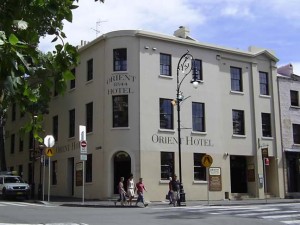
This site was in the original grounds of Sydney’s first hospital complex and later was enclosed by fencing to become a part of the Surgeon General’s residence. In June 1828, the allotment was part of a land grant made. By 1853, the house had become a hotel called the ‘Marine Hotel’, which became the ‘Orient Hotel’ in 1884. The residence erected by Chapman was described in 1845 as being constructed of brick with shingle roof, three storeys high with basement, possessing ‘every convenience’. The original single storey shop at 87 George Street seems to have been a single storey structure, operated as a butchers shop by Chapman until his death in 1858. The shop remained until 1930-31 when Tooth & Co. replaced it with the present Art Nouveau additions to the Orient Hotel. In 1876 the Hotel was sold to Gustave Buckham and renamed ‘Buckham’s Hotel’; then in 1878-82 the ‘May’s Family Hotel’; and in 1882-84 the ‘Pries Family Hotel’ before, in 1884, becoming once again the ‘Orient Hotel’.
Posted: March 16th, 2013 | No Comments »
Just noting the Man Asian Literary Prize was won by Malaysia’s Tan Twan Eng for The Garden of Evening Mists…I’d have gone for Jeet Thayil’s Narcopolis, but there you go…
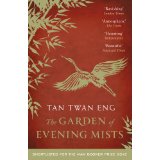
It’s Malaya, 1949. After studying law at Cambrige and time spent helping to prosecute Japanese war criminals, Yun Ling Teoh, herself the scarred lone survivor of a brutal Japanese wartime camp, seeks solace among the jungle fringed plantations of Northern Malaya where she grew up as a child. There she discovers Yugiri, the only Japanese garden in Malaya, and its owner and creator, the enigmatic Aritomo, exiled former gardener of the Emperor of Japan. Despite her hatred of the Japanese, Yun Ling seeks to engage Aritomo to create a garden in Kuala Lumpur, in memory of her sister who died in the camp. Aritomo refuses, but agrees to accept Yun Ling as his apprentice ‘until the monsoon comes’. Then she can design a garden for herself. As the months pass, Yun Ling finds herself intimately drawn to her sensei and his art while, outside the garden, the threat of murder and kidnapping from the guerrillas of the jungle hinterland increases with each passing day. But the Garden of Evening Mists is also a place of mystery. Who is Aritomo and how did he come to leave Japan? Why is it that Yun Ling’s friend and host Magnus Praetorius, seems to almost immune from the depredations of the Communists? What is the legend of ‘Yamashita’s Gold’ and does it have any basis in fact? And is the real story of how Yun Ling managed to survive the war perhaps the darkest secret of all?
Posted: March 15th, 2013 | 1 Comment »
Like most China Hands of a certain vintage I’ve heard Sidney Rittenberg speak several times and of course knew his autobiography, The Man Who Stayed Behind. Now there is a documentary about his life (I’m going to assume resaders of this blog know who Rittenberg is, but if you don’t then click here) – The Revolutionary. Apparently, so I hear from people who’ve seen screenings, it is excellent and I guess screenings and showings will be cropping up all over, hopefully also in China.
The producers have also done a great website to go with the documentary with a lot of information and sources on it…watch out for screenings I guess or DVDs available at the web site.
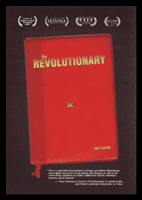
Posted: March 15th, 2013 | No Comments »
Details and an invitation an invitation to the next event in our AHRC China in Britain: Myths and Realities series. It is to be held on London’s Regent Street on April 27th. If you would like to attend (and it is free) then please rsvp anne@translatingchina.info to reserve a place. A full programme with abstracts and biogs etc will appear on the translatingchina website and below the (rather charming) image….
Archiving: China in Britain (5)
Saturday April 27th 2013
9.30am-5pm
The Boardroom
309 Regent Street
London W1B 2UW
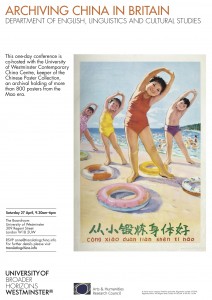
09:30AM Coffee/welcome
10:00AM ‘Shifting tastes in Chinese art: a history of the Berkeley Smith collection of Chinese ceramics at Cheltenham Art Gallery & Museum (1921-1958)’ Louise Tythacott (University of Manchester )
In September 1921, Stanley Berkeley Smith (1878-1955), a British banker based in Karachi, offered his collection of Chinese ceramics on long term loan to Cheltenham Art Gallery & Museum. It comprised over 800 pieces, including sets of large celadon chargers and ornately decorated blue and white dishes. Berkeley Smith had spent the previous 21 years acquiring these objects in India at considerable personal expense – this was, for its time, Britain’s largest collection of non-court Chinese ceramics exported to the sub-continent. A Chinese porcelain room was duly opened at the Museum in 1923, dedicated to Berkeley Smith’s collection and celebrated as ‘a treasure in Cheltenham’. Tastes in Chinese ceramics, however, were changing. From the late 1920s until the 1950s, Cheltenham’s curator, D. W. Herdman, invited dealers and curators from London to inspect Berkeley Smith’s collections. These metropolitan connoisseurs displayed a marked disdain for the banker’s tastes, preferring simpler archaeological wares from China. One influential Oriental dealer, Edgar Bluett, even recommended that some of Berkeley Smith’s pieces were not ‘museum worthy’ and thus should be disposed of. So it was that between 1946 and 1960 hundreds of his pieces were sold at auction in Cheltenham and at Sotheby’s in London. Cheltenham Art Gallery & Museum today holds fewer than 150 pieces from the original Berkeley Smith collection.
This paper will examine the relationship between the collector, the museum and the art market over a period of more than 30 years through close analysis of letters in the archives. It will explore the impact of one dealer, in particular, on the future of the objects, and will also discuss how Berkeley Smith’s collection became entangled in the shifting landscapes of connoisseurship and taste in Chinese art at this time.
Dr Louise Tythacott is a Lecturer in Museology at the University of Manchester. Her research focuses on the interpretations of Chinese material culture in museums. She has worked in various capacities in museums, latterly as the curator of Asian collections at Liverpool Museum (1996-2003), part of the National Museums Liverpool. Her latest book, The Lives of Chinese Objects: Buddhism, Imperialism and Display, was published by Berghahn in 2011.
10:30AM ‘Let’s talk about the money’ Helen Wang (Dept of Coins and Medals, The British Museum)
Helen Wang looks after the Museum’s collection of East Asian coins and banknotes. Her special interests include the archaeologist Sir Aurel Stein (1862-1943), his extensive collections, the Silk Road and the use of textiles as money. She has published on fascinating aspects of the British Museum’s East Asian money collection: for example, Chinese secret society money and membership certificates; the logistics of transporting copper for coinage in nineteenth century China; paper money design in Shanghai in the 1900s; bronze token money of Jiangsu province in the 1930s; and images of Mao Zedong on Chinese money in the twentieth century.
11:00AM Coffee
11.15AM‘The First Chinese Books in London’ Frances Wood (Keeper of China Collections at the British Library)
Frances Wood studied Chinese at the universities of Cambridge, Peking and London and is Curator of the Chinese collections at the British Library. Among her books are a translation of Dai Houying’s novel Ren a ren! (Michael Joseph, 1992), Did Marco Polo Go To China? (Secker And Warburg, 1995), No Dogs and Not Many Chinese: Treaty Port Life in China 1843-1943 (John Murray, 2000), Hand Grenade Practice in Peking: my part in the Cultural Revolution (John Murray, 200), The Silk Road (University of California Press, 2002), The Blue Guide to China (revised edition, 2002), The Forbidden City (British Museum Press, 2005), The Lure of China (Yale University Press, 2009), and The Diamond Sutra (British Library, 2010).
11:45AM Panel/Questions
12:15PM ‘Mapping An Archive of Chinese Representations in British Cinema’ Hiu M. Chan (University of Cardiff)
This presentation will introduce a database that Hiu M. Chan has been compiling of British films that represent China and Chineseness from the beginning of British cinema history. Her analysis will focus on such questions as when the theme of translating China in Britain film became popular, and the impact of these films in British society.
Hiu M. Chan is a Film and Cultural Studies PhD candidate at Cardiff University. Her thesis focuses on comparisons and possible translation between Chinese and Western film theory. She has published ‘Butterfly and Spinning Top’ in Inception and Philosophy (2011), where she uses ancient Chinese philosophy and Daoist writing on dreams to interpret the film Inception. hiuandfilm.wordpress.com about
12:45 Title TBA Katie Hill (Sotheby’s)
Dr Katie Hill has extensive experience in the field of contemporary Chinese art. Her recent work includes In Conversation with Ai Weiwei, Tate Modern; selector panel/author, Art of Change, New Directions from China, Hayward Gallery, London, and specialist advisor for The Chinese Art Book (Phaidon 2013). She also co-edited a special issue of the journal Visual Art Practice on Contemporary Chinese Art and Criticality, published in 2012. She is director of OCCA (Office of Contemporary Chinese Art) – an art consultancy promoting Chinese artists in the UK.
1:30PM – 2:30PM Buffet Lunch served – all welcome
2:30PM ‘The Historical Photographs of China Project’ Robert Bickers (University of Bristol)
Since 2006, the Historical Photographs of China project has been locating, digitising, and publishing online thousands of photographs of China from the pre-1949 period. Mainly located in private hands, mostly from families in Britain with a historic connection to China, they cover a wide variety of subjects and locales, and range from the 1860s to the 1940s. The resource is open access, and currently holds over 8,000 images, with many more being processed. Its associated portal ‘Visualising China’ offers access across additional online collections. This talk introduces the project and its development, as well as some of its core collections, and discusses some of the issues this work has raised.
Robert Bickers is Professor of History at the University of Bristol and Director of the British Inter-University China Centre bicc.ac.uk
Historical Photographs of China project: hpc.vcea.net
Visualising China: visualsingchina.net
Project blog visualisingchina.net/blog
3:00PM Afternoon Tea
3.15PM ‘Found In Time: My Shanghai Heritage’ Peter Hibbard MBE, (Former President and Founder of the North China Branch of the Royal Asiatic Society)
Today Shanghai plays host to nearly 200,000 foreign residents and aspires to restore its former status as Asia’s premier international centre for trade, finance and commerce. In the 1930s over 10,000 Britons called Shanghai home and although only a dwindling number of pre-1949 residents still survive, their legacy of Britain in China has now been transposed as relatives search for the China of their forbears. Aided by expanding physical and online archives, genealogical sites and social network forums, as well as the availability of travel to China, many British families are reconstructing maps of their heritage that cross generations and continents. Some are fortunate in holding substantial family archives and these have been of keen interest to a small group of academics, but it is more often the case that only fragments of the past have survived because so much was lost in periods of turbulence from the late 1930s to the early 1950s.
Most remarkably, former foreign libraries and archives, including those of the North China Branch of the Royal Asiatic Society and the Shanghai Municipal Council, whose fate was previously unknown and many feared lost, have been opened to the public in the past decade providing inspiration and sustenance to scholars and to those piecing together personal or corporate histories. Despite the onslaught of modern development, substantial swathes of once foreign-owned Shanghai houses remain, and numerous personal and institutional artefacts are adding another dimension to an archival history that has been distanced by time and dispossession. In many ways Shanghai’s past physical form and its social ethos have been officially catalogued and displayed as something removed from the modern city. This presentation will explore issues related to recovering the past, and the resources available, and will highlight the cases of various families. It will also discuss efforts to provide platforms that assist interested parties in recognising and sharing their heritage.
Peter Hibbard MBE is a Shanghai-based historian, heritage consultant, author and travel professional who strives to foster an understanding and appreciation of Shanghai’s unique historical inheritance. He is particularly concerned with connecting the past with the present, and in 2007, following an absence of over 50 years, he resuscitated the former North China Branch of the Royal Asiatic Society in Shanghai. He has published widely, including The Bund Shanghai: China Faces West (2007) and Beyond Hospitality: The History of The Hong Kong and Shanghai Hotels, Ltd. (2010)
shanghai-flaneur.com
3.45PM ‘Maoist posters in London: A perspective from the University of Westminster’ Emily Williams (University of Westminster)
The Chinese Visual Arts Project was established at the PCL, and the first public exhibition of posters was held in April 1979. With generous help from a small number of colleagues and friends in the China field who had visited or lived on the mainland, the core of the present collection was quickly established, extending back into the 1960s.
Emily Williams is a research assistant at the University of Westminster’s Chinese Poster Collection (chinaposters.westminster.ac.uk), where she is working to catalogue and digitise the university’s collection of Chinese posters dating from the 1950s to the early 1980s. She is also a PhD student at the London Consortium (Birkbeck College, University of London), where she is studying British interactions with Cultural Revolution objects, focusing on collections and exhibitions of these objects, both during the Cultural Revolution and since.
Posted: March 14th, 2013 | No Comments »
Italians everywhere will be delighted that the Italian language edition of Midnight in Peking – Mezzanotte a Pechino – is now available and with a lovely cover too from the esteemed publishing house of Einaudi. Details in Italian below….Much thanks to Einaudi and my translator Anna Rusconi.
Brilliante!!
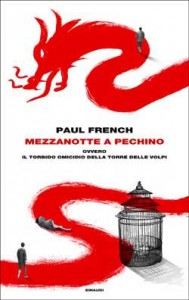
Pechino 1937. Pochi giorni dopo Natale Pamela, la giovane figlia di un diplomatico britannico, è rinvenuta uccisa e orrendamente mutilata ai piedi di un’antica fortificazione. A occuparsi del caso, realmente accaduto, sarà una strana coppia di investigatori: lo scrupoloso ex detective di Scotland Yard Richard Dennis e l’ambiguo e scaltro colonnello cinese Han.
Sullo sfondo, un naturale scenario da racconto giallo. Una vecchia Cina sospesa tra l’impero e la rivoluzione, dove gli spiriti volpe imperversano nottetempo per la Città Tartara e il sospetto di pratiche sessuali illecite aleggia nei vicoli, mescolato al profumo dell’oppio.
Posted: March 13th, 2013 | No Comments »
I recently read Steven Poole’s You Aren’t What You Eat: Fed Up with Gastroculture – I liked this book, I’d been waiting for this book, I am giving this book to people as essential reading because I am not a foodie, don’t like foodies and think the whole food obsession as manifesting itself these days in the west rather silly. Poole, hilariously, punctures the whole bubble of food as religion – buy a copy and read it and you’ll never go near dodgy celebrity chefs or anyone offering “foam” again. I know some people don’t agree – I saw one rather earnest American author fire off at Poole in a fit of rage in Australia recently violently objecting to him mocking foodies just proving he is needed more than ever.
Still, he did put me on to one rather luscious example of food Chinoiserie – which he got, to be fair, from ridiculous chef Heston Blumenthal. Blumenthal is a great admirer of a celebrity chef in the early nineteenth century, Marie-Antoine Careme (apologies, I can’t find the “accents” button to add in the correct Frenchy bits) and apparently invented the daft and pointless toque, or chef’s hat. Anyway, Blumenthal tells of a dinner given for 40 people by the Prince Regent at the Brighton Pavilion (a building of course at the apex of Chinoiserie architecture and interior decoration) – a first course of 48 dishes was followed by eight Careme creations including something called a “Chinese Hermitage” and another dish entitled “The Ruin of a Turkish Mosque”.
There is though some disagreement – others recall eating a specially created “Dutch Hermitage” and (even better) a “Chinese Pagoda”. This may be more accurate as there is indeed a recipe for the latter in Careme’s 1815 best selling cookbook Le Pâtissier Royal Parisien. Careme described all of these themed dishes of his as “pièces montées. And, I don’t believe Poole includes this in his many silly things self-important chefs have said over the centuries but, Careme’s comment that “Architecture is the first amongst the arts, and confectionery is the highest form of architecture” is worthy of inclusion.
And here’s thw disappointing ending to this post – despite searching the internet I can’t find an image of the Careme’s Chinese Pagoda in pastry. I have his Russian Hermitage and Athenian Ruin (both below) but no Chinese Pagoda – anyone got one??


 The RAS Library at Sino-British College in Shanghai
The RAS Library at Sino-British College in Shanghai









